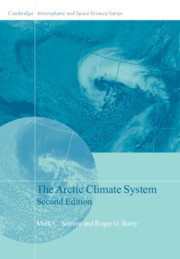Book contents
- Frontmatter
- Dedication
- Contents
- Preface
- Acknowledgments
- List of Acronyms
- List of Selected Web Sites
- 1 The Evolution of Knowledge about the Arctic and Its Climate
- 2 Physical Characteristics and Basic Climatic Features
- 3 The Basic Atmospheric and Ocean Energy Budgets
- 4 The Atmospheric Circulation
- 5 Energy Exchanges at the Surface
- 6 Precipitation, Net Precipitation, and River Discharge
- 7 Arctic Ocean–Sea Ice–Climate Interactions
- 8 Climate Regimes of the Arctic
- 9 Modeling the Arctic Climate System
- 10 Arctic Paleoclimates
- 11 The Uncertain Future
- References
- Index
- Plate Section
5 - Energy Exchanges at the Surface
Published online by Cambridge University Press: 05 August 2014
- Frontmatter
- Dedication
- Contents
- Preface
- Acknowledgments
- List of Acronyms
- List of Selected Web Sites
- 1 The Evolution of Knowledge about the Arctic and Its Climate
- 2 Physical Characteristics and Basic Climatic Features
- 3 The Basic Atmospheric and Ocean Energy Budgets
- 4 The Atmospheric Circulation
- 5 Energy Exchanges at the Surface
- 6 Precipitation, Net Precipitation, and River Discharge
- 7 Arctic Ocean–Sea Ice–Climate Interactions
- 8 Climate Regimes of the Arctic
- 9 Modeling the Arctic Climate System
- 10 Arctic Paleoclimates
- 11 The Uncertain Future
- References
- Index
- Plate Section
Summary
Overview
As reviewed in Chapter 3, the mean annual cycle of energy storage in the Arctic atmosphere is determined by the interactions between the net radiation budget at the top of the atmosphere, horizontal energy transport convergence, and the vertical net surface flux. The vertical net surface flux was in turn shown to be the key driver of the annual cycle in the energy content of the underlying Arctic Ocean. In this chapter, we look at surface energy transfers in more detail. Even today, direct surface measurements of the various surface energy fluxes, especially in a spatially distributed sense, are rather sparse. However, a reasonably comprehensive picture can be assembled by using available surface observations along with satellite-derived products and model results.
Shortwave radiation exchanges at the surface are strongly influenced by the high albedo of snow and ice. Both shortwave and longwave radiation exchanges at the surface are greatly influenced by cloud cover; the former largely through cloud albedo, and the latter through impacts on the effective atmospheric emissivity and temperature. During winter, the surface net radiation budget is almost always directed away from the surface (upward). Over land, this upward net radiation flux is typically accompanied by a small downward sensible heat flux from the atmosphere to the surface, and a small upward conductive flux through the snow cover. Over the Arctic Ocean, the upward surface net radiation flux in winter is typically balanced by a small downward sensible heat flux and upward conductive fluxes through the snow cover, sea ice, and areas of open water. Away from areas like the Atlantic sector, where there can be strong temperature advection, changes in the winter surface air temperature are closely tied to changes in the longwave radiation budget. Winter is characterized by strong temperature inversions, typically extending up to 1,000–1,200 m. The inversion layer is fundamentally maintained through an approximate radiative equilibrium associated with the different emissivities of the snow surface (nearly a blackbody) and the temperature maximum layer aloft (a selective emitter), with poleward energy transports balancing the radiation loss to space.
- Type
- Chapter
- Information
- The Arctic Climate System , pp. 138 - 176Publisher: Cambridge University PressPrint publication year: 2014



